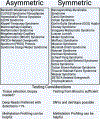Overgrowth syndromes, diagnosis and management
- PMID: 37791807
- PMCID: PMC10872759
- DOI: 10.1097/MOP.0000000000001298
Overgrowth syndromes, diagnosis and management
Abstract
Purpose of review: This review will focus on the current knowledge of the diagnosis and management of overgrowth syndromes with specific focus on mosaic conditions and treatment strategies.
Recent findings: With the implementation of massively parallel sequencing, the genetic etiology of many classically described overgrowth syndromes have been identified. More recently, the role of mosaic genetic changes has been well described in numerous syndromes. Furthermore, the role of imprinting and methylation, especially of the 11p15 region, has been shown to be instrumental for growth. Perhaps most importantly, many overgrowth syndromes carry an increased risk of neoplasm formation especially in the first 10 years of life and possibly beyond. The systematic approach to the child with overgrowth will aide in timely diagnosis and efficiently align them with appropriate screening strategies. In some cases, precision medical interventions are available to target the perturbed growth signaling pathways.
Summary: The systematic approach to the child with overgrowth aids in the standardization of the diagnostic pathway for these young patients, thereby expediting the diagnostic timeline, enabling rigorous monitoring, and delivering tailored therapeutic interventions.
Copyright © 2023 Wolters Kluwer Health, Inc. All rights reserved.
Conflict of interest statement
Conflicts of interest
None
Figures
Similar articles
-
The Black Book of Psychotropic Dosing and Monitoring.Psychopharmacol Bull. 2024 Jul 8;54(3):8-59. Psychopharmacol Bull. 2024. PMID: 38993656 Free PMC article. Review.
-
[Volume and health outcomes: evidence from systematic reviews and from evaluation of Italian hospital data].Epidemiol Prev. 2013 Mar-Jun;37(2-3 Suppl 2):1-100. Epidemiol Prev. 2013. PMID: 23851286 Italian.
-
Management of urinary stones by experts in stone disease (ESD 2025).Arch Ital Urol Androl. 2025 Jun 30;97(2):14085. doi: 10.4081/aiua.2025.14085. Epub 2025 Jun 30. Arch Ital Urol Androl. 2025. PMID: 40583613 Review.
-
Grommets (ventilation tubes) for hearing loss associated with otitis media with effusion in children.Cochrane Database Syst Rev. 2005 Jan 25;(1):CD001801. doi: 10.1002/14651858.CD001801.pub2. Cochrane Database Syst Rev. 2005. Update in: Cochrane Database Syst Rev. 2010 Oct 06;(10):CD001801. doi: 10.1002/14651858.CD001801.pub3. PMID: 15674886 Updated.
-
Uncommon Non-MS Demyelinating Disorders of the Central Nervous System.Curr Neurol Neurosci Rep. 2025 Jul 1;25(1):45. doi: 10.1007/s11910-025-01432-8. Curr Neurol Neurosci Rep. 2025. PMID: 40591029 Review.
Cited by
-
Coupling deep phenotypic quantification with next-generation phenotyping for 192 individuals with germline histonopathies.HGG Adv. 2025 Jul 10;6(3):100440. doi: 10.1016/j.xhgg.2025.100440. Epub 2025 Apr 15. HGG Adv. 2025. PMID: 40241305 Free PMC article.
References
-
-
Becker J, Gross UC, Weber DM, et al. PIK3CA Mutational Analysis in Patients With Macrodactyly. Pediatr Dev Pathol. 2022;25(6):624–34.
Clinical case series discussing 14 PROS patients with macrodactyly found that formalin-fixed paraffin-embedded material was suitable for analysis.
-
-
-
Shen XF, Gasteratos K, Spyropoulou GA, et al. Congenital difference of the hand and foot: Pediatric macrodactyly. J Plast Reconstr Aesthet Surg. 2022;75(11):4054–62.
Macrodactyly in PIK3CA can be effectively treated with surgery.
-
-
-
Zamary AR, Mamlouk MD. Neuroimaging features of genetic syndromes associated with CNS overgrowth. Pediatr Radiol. 2022;52(13):2452–66.
**Overgrowth syndromes, in particular those related to the PI3K-AKT-mTOR pathway can result in a variety of central nervous system overgrowth signs, reviewed in this paper.
-
-
-
Hayoun-Vigouroux M, Audebert S, Vabres P, et al. Muscle hemihypertrophy syndrome with PIK3CA gene mutation associated with Tourette syndrome. JAAD Case Rep. 2022;30:128–30.
The authors report on a novel case of a young female patient with PROS and Tourette Syndrome.
-
-
-
Qaisar F, Butt NI, Ajmal Ghoauri MS, et al. Proteus Syndrome: A Rare Disease Of Disproportionate And Asymmetric Overgrowth Of Connective Tissue. J Ayub Med Coll Abbottabad. 2023;35(1):177–9.
The authors report on a novel case of Proteus syndrome diagnosed in an adult female with asymmetric overgrowth of the upper limb.
-
Publication types
MeSH terms
Grants and funding
LinkOut - more resources
Full Text Sources
Research Materials



